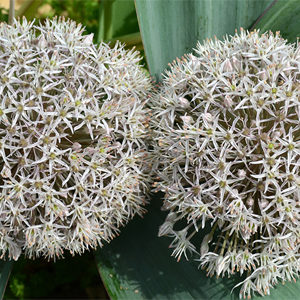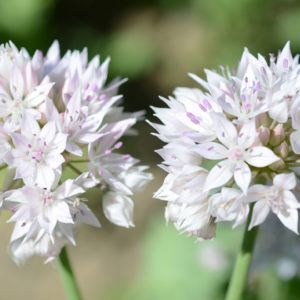Description
 Allium,
Allium,
Stipitatum
White Giant
The Allium family includes an enormous collection of plants including leeks, onions, elephant garlic and shallots. There are more than 200 species and thousands of cultivars. In the wild, they are found all over the Northern Hemisphere including North America, the Middle East, western China, the Pyrenees, the Alps and the Mediterranean. They flourish with exposure to full sun, in rugged mountainous areas where the ground drains quickly and completely. They also love bonemeal, so add a generous helping of bonemeal (1/4 cup) to the hole where you plant each bulb.
Of all the ‘critter resistant’ bulbs, the Alliums are the most ‘critter resistant’. Deer, rabbits, squirrels, mice, moles and voles cannot stand the smell of Alliums. The fragrance is so strong and so offensive to critters that Alliums can be used to deter the critters from tulips and other more vulnerable bulbs. A critter has to be really desperate to eat an Allium.
Allium stipitatum, White Giant is the tallest of the white alliums and because of its dense floret structure, it is the fuzziest. Its showy fuzziness will bring a smile to your face every morning. Stipitatum is native to Turkestan, Afghanistan and central Asia where it grows on the rocky slopes and in the soil depleted scree fields on the sides of mountains at elevations of 4,900 – 8,200 feet. In Europe and along the eastern Mediterranean, it is known as the ‘Persian Shallot’.
The word, stipitatum, derives from Latin and means ‘with a little stalk’. This is a reference to the stalk which holds the large ovaries (the green blobs at the end of each floret stem). Though the White Giant ovaries are very large, they are not larger than some other allium cultivars. The photo above shows you the ovaries. The one below shows you the ‘little stalk’.
The plants can grow to heights of 48 inches, but in my experience, they rarely grow taller than 36 inches. The globes are very large – 6 inches, sometimes larger. They are very vigorous and multiply more rapidly than most of the giant globe alliums. They are hardy from Hardiness Zones 4-9, and bloom in late spring to early summer. White Giant blooms for a long time in the spring garden. From the time the buds burst until the globes fade is usually 4-6 weeks.
The florets open successively gradually forming a gloriously fuzzy globe. The fuzzy impression is the result of unusually long anthers protruding from the base of the ovaries. The very densely packed florets usually form a nearly perfect globe.
The bulb of Allium stipitatum is used in Persian cuisine. The bulbs are usually harvested from the wild varieties which are indigenous to the Zagros Mountains. These bulbs are sliced, dried and then sold in the street markets of cities, towns and villages. Once purchased, the slices are soaked for several days and then cooked by boiling. Once boiled to a soft texture, the slices are then crushed and often mixed with yogurt.
The bulbs have been used for centuries for some medicinal purposes. They contain a chemical compound that has been known to be toxic to the tuberculosis mycobacterium. They also contain pyrithione which is known to be moderately toxic to some human tumor cell lines, some fungi and gram-negative bacteria.
Allium stipitatum has been known and used by the civilizations of the MiddleEast for thousands of years. Because of the traffic on the trade routes and the 19th century mobility of Europeans and Brits, this lovely allium made its way to Europe and the United Kingdom where it became a rare, but much admired part of western gardens.
Planting Bulbs in the Fall for Glorious Spring Color
Bulbs are some of the easiest plants to grow. Fundamentally the process requires four steps.
1. Dig a hole.
2. Dust the hole with bonemeal.
3. Place the bulb in the hole.
4. Fill the hole with soil.
There are, however, some additional refinements which help produce even more lavish results and enhance protection from critters.
First, bulbs can and should be planted deeper than the instructions you receive on the package labels. An easy way to remember how deep to plant the bulb is to think of a quarter. If the bulb you are planting has the same diameter as a quarter or less, plant the bulb 4 inches deep. If the bulb is broader than a quarter, plant it 6-10 inches deep. Large bulbs like some alliums, camassias, standard tulips and fritillaries can easily be planted 10 inches deep. As the soil compacts days, weeks and months after planting, it produces a thinner layer of soil on top of the bulb. Planting bulbs deep helps with critter control. Moles, voles, chipmunks and squirrels are lazy little creatures, and they don’t like doing a lot of digging to reach their food.
Second, bonemeal is a must. It is an excellent source of calcium and phosphorus which help the bulbs to form a strong root system and healthy stems. For large bulbs (those bigger than a quarter), use ¼ cup per bulb. For small bulbs, dust the entire surface or hole where the bulbs will reside.
Third, small bulbs should be planted in clusters of 10 or more – 1 inch apart. Large bulbs, like allium, can stand along, but create a much more pleasing presence in the garden when planted is clusters of 3-5. They should be separated by no more than 4-6 inches.
Fourth, bulbs usually multiply fairly quickly and once crowded will not produce blossoms. Plan to divide your bulbs in mid-summer to fall when the top growth has dried out.
These simple, easy, quick tasks are all that is required to produce a lovely bulb display year after year.
Planting Bulbs in Containers
If you live in Hardiness Zones 5 and higher all you need to do is mix some soil. . Check out the soil mix described in detail in our Harvesting History YouTube video. Do not use prepared soil mixes.
The Best Soil Mix for Containers
Always plant bulbs more densely in containers than in the ground. Pots as small as 6-inches in diameter can have a showy presence on a deck, porch or patio. You can use much larger pots and plant several kinds of bulbs.
Fill the pot half full, dust the soil surface with bonemeal, arrange the bulbs on top of the bone meal and fill the pot with the rest of the soil. Dust the surface of the soil with more bonemeal. Water thoroughly, but do not let the pot stand in a saucer of water.
If you live in Hardiness Zones 1-4, you must protect the pots by bringing them into an unheated garage or surrounding them with bales of straw. If you do not do this, the bulbs usually freeze and turn to mush.
Introduction to Fall Bulbs
Introduction HH Allium Collection
Allium Amplectens, Graceful Beauty
Allium Nigrum – Bulbs for Fall Planting
Allium Caesium AKA Allium Urecolatum – Bulbs for Fall Planting
Bulbs for Fall Planting: Allium stipitatum White Giant









